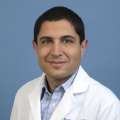Pectus Excavatum and Carinatum Repair
Find your care
UCLA Health pediatric surgeons specialize in delivering outstanding surgical care to every child. Call 310-206-2429 to connect with an expert.
Pectus Excavatum, Pectus Carinatum, and Other Chest Deformities
Pectus excavatum (also known as "sunken chest syndrome" or "funnel chest") is an abnormality of the chest wall in which the front ribs and breast bone (sternum) appear indented and sunken toward the spine. It is the opposite of another condition called pectus carinatum (also known as "pigeon chest") where the front part of the chest appears to protrude or 'stick out'. Researchers are not sure what triggers the deformity, but it is thought to be caused by abnormal or excessive growth of rib cartilage. This causes the cartilage to buckle, pushing the sternum inward or outward.
These type of chest deformities are actually more common than most people think, as they are present in up to 1 out of every 300 persons. Although the condition may be noticeable at birth, it often becomes much more apparent in the period of rapid growth at the onset of puberty. The degree of abnormality can vary from very mild to very severe. In moderate to severe cases, the rib cage can press against the heart and lungs causing chest pain, breathing difficulty with exertion, early fatigue, and reduced tolerance for exercise. Standard methods of evaluation for pectus deformities include a chest x-ray (PA and lateral) or chest CT scan. In order to minimize exposure to radiation, the severity of the deformity (pectus severity index or Haller index) can be determined by x-rays alone (without the need for CT-scan). Pulmonary function tests and an echocardiogram (ultrasound of the heart) may also be performed for individual patients. The criteria for surgical correction in most circumstances include a symptomatic moderate to severe pectus deformity with a Haller index of greater than 3.2 (a normal index being around 2.5). Those individuals that may also have features of connective tissue disorders may get referred and evaluated by the multidisciplinary UCLA Marfan's Center.
Procedure for Repair of Pectus Pectus Excavatum and Carinatum
UCLA pediatric surgeons have an extensive experience in treating pectus excavatum and other chest wall disorders. UCLA Mattel Children's Hospital has served as a major referral center for chest anomalies treating children from southern California, across the United States, and even international locations. Surgical correction of 'sunken chest' is generally recommended when patients have moderate to severe malformations or experience symptoms related to the condition. It is now recognized that the best age to perform the repair is during early adolescence to help minimize the chance of recurrence at a later age. In the standard open or modified Ravitch procedure, doctors make an incision across the chest just below the nipples. The portions of the deformed cartilages are removed, and the sternum is gently cracked and repositioned. A short stabilizing bar is placed for additional support to the sternum. Dr. Fonkalsrud, Professor Emeritus at UCLA, has made significant modifications to the Ravitch procedure to minimize removal of cartilage, facilitate chest wall remodeling, and improve outcomes. His technique continues to be utilized at UCLA. The bar stays in place for 6 months. In the six to eight weeks after surgery, new cartilage forms to hold the sternum and ribs in position.
A relatively newer technique for correction of sunken chest is the Nuss procedure, named for the now retired surgeon who introduced it in 1998 after publishing his experience with it after 10 years. Since that time, the Nuss procedure has become the most popular method to repair pectus excavatum.
Nuss Procedure for Repair of Pectus Excavatum
The Nuss procedure is a minimally invasive surgery where small 1 inch incisions are made on each side of the rib cage. A curved, custom-shaped, stainless steel pectus bar is guided through the rib cage and beneath the sternum. Once in place the rod is rotated, turning the curved portion against the chest wall, pushing the ribs and sternum out. The procedure works in much the same that orthodontic braces remodel teeth. In the majority of cases, cartilage or bone is not removed. The bar is secured to the ribs under the skin with stitches and is left in place for two to three years.
The correction of the chest deformity is immediate. The recovery time for the traditional and minimally invasive approaches is similar with a 3 to 5 day stay in the hospital. However, patients and families often prefer the Nuss procedure to traditional surgery because the operation is shorter, has less blood loss, and uses smaller incisions resulting in less scar. Removal of the bar requires a short procedure that can be performed in the outpatient surgery center.
Our Experts
Contact Us
(310) 206-2429 Appointments
(310) 206-1120 Fax





